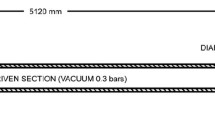Abstract
It is shown that preloading of fine-grained copper with a the grain size of 0.5 m by a shock wave of intensity ≈25–50 GPa does not lead to changes in its internal microstructure and mechanical properties, and the dislocation density increases only slightly from 1.8 · 1011 cms-2 in the initial state to (3.1–3.6) · 1011 cms-2 after shockwave loading. An increase in shock wave intensity to pressures > 55 GPa leads to a decrease in the dislocation density to 2.5 · 109 cms-2, an increase in the grain size to ≈19 fum, the occurrence of microtwins inside the grains, and a reduction in the mechanical properties of fine-grained copper to the level of coarse-crystalline copper.
Similar content being viewed by others
References
M. A. Meyers and L. E. Murr, (ed.) Shock Waves and High-Strain Rate Phenomena in Metals, Plenum Press, New York-London (1980).
G. H. Epstein, Structure of Metals Deformed by Explosion [in Russian], Metallurgiya, Moscow (1988).
G. A. Salishew, V. A. Raevskii, O. N. Ignatova, et al., “Influence of intensive plastic strain and shock-wave loading on copper strength,” in: New Models and Hydrocodes for Shock Wave Processes in Condensed Matter, Int. Conf., Dijon, France, April 9-14 (2006), p. 17.
J. Petit and J.-L. Dequiedt, “Constitutive relations for copper with two mechanisms including twinning for a use under shock wave loading,” J. Phys. IV, France, 110 (2003).
V. A. Raevsky, “Heterogeneous deformation of copper in shock waves at subgrain scale level,” in: 14th APS Total Conf. on Shock Compression of Condensed Matter, Vol. 50, No. 5 (2005).
V. A. Raevskii, A. M. Podurets, O. N. Ignatova, et al., “Effect of high-velocity loading on the microstructure and dynamic properties of copper,” in: IX Kharitonov Scientific Readings, Proc. Conf., Inst. of Exp. Phys., Russian Federal Nuclear Center, Sarov (2007).
S. V. Zherebtsov, R. M. Galeev, O. R. Valiakhmetov, et al., “Formation of submicrocrystalline structure in titanium alloys by intense plastic deformation and their mechanical properties,” Kuzn.-Shtamp. Proizv., No. 7, 17–22 (1999).
N. F. Gavrilov, G. G. Ivanova, V. I. Selin, and V. N. Sofronov, “UP-OK Program for solving onedimensional problems of continuum mechanics in a onedimensional complex,” Vopr. Atom. Nauki Tekh.,, 3 (11), 11–14 (1982).
V. A. Raevskii, A. M. Podurets, and V. G. Khanzhin, “Twin structures in copper after impact and nonimpact high-velocity loading,” in: IX Kharitonov Scientific Readings, Proc. Conf., Inst. of Exp. Phys., Russian Federal Nuclear Center, Sarov (2007).
Ya. S. Umanskii, Y. A. Skakov, A. N. Ivanov, and L. N. Rastorguev, Crystallography, X-Ray Diffraction and Electron Microscopy [in Russian], Moscow (1982).
M. Haberjahn, P. Klimanek, and M. Motylenko, “Substructure development in cold rolled copper single crystals,” Mater. Sci. Eng., A, 324, 196–199 (2002).
M. Zehetbauer, T. Ungar, et al., “Scanning Xray diffraction peak profile analysis in deformed Cupolycrystals by synchrotron radiation,” Acta Mater., 47, 1053–1061 (1999).
N. A. Koneva, E. V. Kozlov, et al., “Substructural and phase transformations during plastic deformations of materials obtained by intensive deformation,” Mater. Sci. Eng. A, 410, 411, 341–344 (2005).
R. Z. Valiev and I. V. Aleksandrov, Nanostructured Materials Obtained by Intense Plastic Deformation [in Russian], Logos, Moscow (2000).
E. Schafler, G. Steiner, et al., “Lattice defect investigation of ECAP-Cu by means of X-ray line profile analysis, calorimetry and electrical resistometry,” Mater. Sci. Eng. A, 410, 411, 169–173 (2005).
J. Taylor, “The testing of materials at high rates of loading,” J. Inst. Civil. Eng. (1946).
Author information
Authors and Affiliations
Corresponding author
Additional information
Translated from Fizika Goreniya i Vzryva, Vol. 46, No. 6, pp. 119–124, November–December, 2010.
Rights and permissions
About this article
Cite this article
Ignatova, O.N., Kaganova, I.I., Malyshev, A.N. et al. Effect of shock-wave loading on the internal microstructure and mechanical properties of fine-grained copper. Combust Explos Shock Waves 46, 719–723 (2010). https://doi.org/10.1007/s10573-010-0096-3
Received:
Revised:
Published:
Issue Date:
DOI: https://doi.org/10.1007/s10573-010-0096-3



